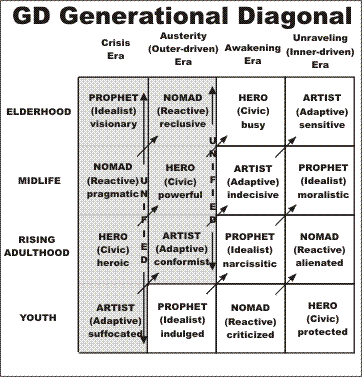
Originally Posted by
William Jennings Bryan
But what did Neil have to say about your data? Did he have an explanation for the late religious activity in the 1910's? Did he question your criteria? Do tell.

He didn't say anything. I didn't press him. S&H do not claim that religious activity would correlate with their generational cycle. The real test is prediction. If S&H eventually come to the conclusion that the Crisis did indeed begin with 911, that would be the time to start a discussion about whether or not the idea of the CWA is valid. If it turns out the crisis starts in 2010 or later, the 18-year turning idea is wrong, it doesn't matter what the religious event data shows. In this case the saeculum after 1929 will be considerably longer than the one before, consistent with its truncation by a skipped generation.
I will take that into serious consideration. Again, I'm still in the Doozy Camp (for good or ill) and I haven't observed the required dooziness just yet.
Suppose you finally see the requisite "dooziness", but then ten years later you see what appears to be the start of a new High (the troubles over, the sun is shining, markets soaring, prosperity fills the land, yada yada yada). You won't want to call the ten year span after the "doozy" event the
entire Crisis (its too short),
especially if the preceding Unraveling is like 25 years long. You will more likely extend the start of the crisis back so it starts 17-18 years before the beginning of the High, and 911 will look mighty handy as a start point.
We have to keep in mind that all previous turnings have been determined with the benefit of hindsight. None have every been detected in real time (this is the first one). What we don't know is the future and this is important to how the current period is interpreted.
I am not saying that today "feels" like a Crisis. It doesn't. I employ "rulers". Using 18-year rulers gives a projection of right around 2001: 1984+18=2002, 1964+36=2000, 1946+54=2000, 1929+72=2001, 1912+90=2002, 1894+108=2002, 1877+126=2003, 1860+144=2004, 1844+163=2006, 1822+180=2002 (average is 2002 +/-2).
I also employ aligned cycles:
Secular Bear Market 1929-1949 --> 1929-1946 [Crisis]
Secular Bull Market 1949-1966 --> 1946-1964 [High]
Secular Bear Market 1966-1982 --> 1964-1984 [Awakening]
Secular Bull Market 1982-2000 --> 1984-2001 [Unraveling]
Secular Bear Market 2000-???? --> 2001-???? [Crisis]
These are the two bases. A second economic indicator has failed to give a confirmatory signal (I've been waiting for 2 1/2 years). Analysis of past election results has shown this to be a not very useful indicator. Bush is likely to win regardless of which turning we are in. So if Bush wins it says nothing about what turning we are in. On the other hand, Kerry is unlikely to win if it be 3T, so a Kerry win
might say something. But then Clinton was unlikely to win in 1992 for the same reasons, yet he did, and that didn't mean that the 3T was over. Unlikely does not mean never.
Two years ago my gut feeling was that the 2004 election would be more of a bellweather. It made sense. But I can't back this feeling up by looking at the track record.
Originally Posted by John J. Xenakis











